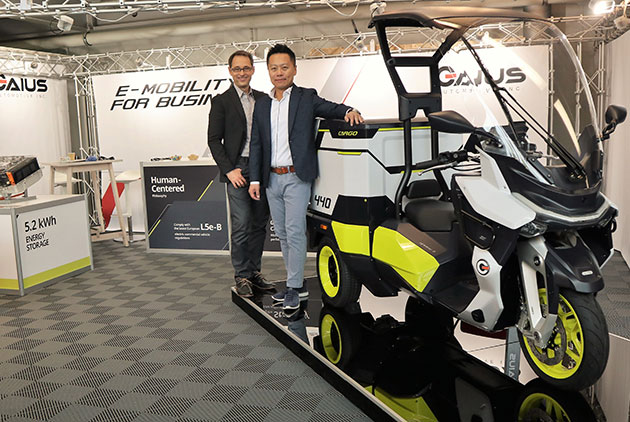Taiwan’s Three-Wheeled Dynamo
Behind the Rise of the Gaius EV

Source:Gaius Automotive
Taichung-based Gaius Automotive and its unusual electric vehicle have yet to gain recognition in Taiwan, but they have stolen the spotlight at trade shows in France and Germany. Why has the company been a hit in Europe and where is it headed?
Views
Behind the Rise of the Gaius EV
By Kwang-Yin Liuweb only
Standing on the platform of the Taichung high-speed rail station, one can see the black and white wall of the Cathay Life Wuri Logistics Park. The top floor of the complex with the best view is the location of Gaius Automative’s new facility.
The nearly 5,000 square-meter building with its industrial feel and a slide that people can use to go from upstairs to downstairs has helped stimulate the R&D team’s creativity.
It was designed by Gaius founder Anthony Wei, who said that once machines are installed in the factory by the end of the year, it will have two production lines than can roll out up to 30,000 vehicles a year.
The product Gaius plans to produce is rather unusual. Though it falls under the category of “electric vehicle,” it is not a typical four-wheeled car or two-wheeled motorbike. Instead, the company’s featured product is a three-wheeler intended for delivering packages or patrolling streets.
Maximizing a Motorbike
In eyeing the urban mobility and urban delivery markets, what inspired Gaius to conceive of a three-wheeled vehicle?
Wei says the insight was based on two major global trends. First, he says, with the explosion in e-commerce in recent years, logistics and e-commerce providers have sought to expand their own vehicle fleets to meet rising demand.
The number of parcels delivered by logistics company President Transnet Corp. over the past six years, for example, has grown at 20 percent a year. Such demand has led e-commerce platform PC Home to take matters into its own hands, its board of directors approving in August a plan for the company to invest in its own logistics fleet.
Second, global warming and the demand for cleaner air among urban residents have led several countries to set timetables for phasing out fuel-powered vehicles. European cities have been the most aggressive in pushing the concept, with Paris, London, Berlin, Madrid, Copenhagen and others all planning to restrict the access of fuel-powered cars to their cities starting sometime between 2020 and 2025.
Gaius’ products are targeted at covering “the last mile” of courier deliveries in urban environments with zero-emissions. The design concept of its three-wheeled “Rapide 3” electric vehicle is to “maximize the capacity of the motorbike.”
The body of the “Rapide 3” falls somewhere between a motorbike and cargo truck, and its design balances the need for capacity and stability on the road. The vehicles have a payload of 200 kilograms, about three times that of a typical motorbike, or between 440 and 600 liters of cargo, some four to six times that of motorbikes.
Wei says the price of his three-wheeler is about 10,000 euros, giving it a price and a cargo capacity that are roughly half those of commercial freight vehicles. But the Rapide 3 is far more maneuverable in tight city streets than a typical freight truck, making it very competitive in environmentally conscious Europe.
Perhaps even more unusual, the three-wheeled vehicle can attain speeds of up to 95 kilometers per hour, fast enough to be allowed on Europe’s expressways. It’s a standard well out of the reach of the vast majority of two-wheeled electric vehicles.
The innovative nature of the product earned Gaius an invite to the biennial IAA Commercial Vehicle Show in Hannover, Germany, in late September. Exhibiting its products in the New Mobility World section, it shared the platform with globally renowned brands such as Volvo, Mercedes-Benz and Michelin, and was the only company present from Taiwan.
At the beginning of October, Gaius was invited by the French government to participate in the biennial Paris Motor Show, the longest permanent automobile show in the world with its 120-year history.
Orders from Germany, France, Spain
Why has Gaius been able to gain this attention? A big reason is that it is a startup, without the burden or limitations of a traditional auto maker looking to move into the electric vehicle market. Another key has been identifying a unique position in the market – a zero emissions three-wheeled vehicle serving the urban delivery market – and staying away from the highly competitive two-wheeled or four-wheeled vehicle markets.
In fact, Gaius had already drawn the attention of the French government at the end of 2015, when it was named as one of 25 laureate startups and the only Taiwanese winner under the “French Tech Ticket” program. The honor enabled Gaius to operate rent-free in a Paris incubator center for six months.
Today, the Gaius team spans three continents. Its team in Paris is responsible for the electric control system and software development; the Toronto unit focuses on the power system and chassis development; and Taiwan is in charge of R&D and manufacturing. The company estimates its workforce will expand to more than 100 people next year from 40 at present.
Wei disclosed that he already has orders from logistics customers in France, Germany and Spain and is currently working with delivery services in Taiwan to develop new models. He estimated that pilot production will begin at the end of this year.
As competition in Taiwan’s electric motorbike sector intensifies and turns it into a “red ocean” market, eight-year-old Gaius has opted to follow a different path. It is eyeing the relatively untapped market for commercial logistics vehicles, with a special emphasis on the European market. Perhaps it will indeed succeed in creating a new “blue ocean” it can call its own. (Read: Debunking the ‘Top-down’ Model)
Translated by Luke Sabatier
Edited by Tomas






